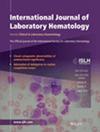Diagnostic Implications of CD63 and CD64 Expression Levels and FcγRIIIA 158 V/F Gene Polymorphism in Primary Immune Thrombocytopenia Adult Patients
Abstract
Objective
Immune thrombocytopenic purpura (ITP) is an acquired autoimmune disease characterized by reduced platelet counts due to immune system dysregulation caused by many factors, including genetics, autoimmune diseases, infections, and inflammations. Therefore, the current study aimed to evaluate immunological markers such as the expression level of lysosomal associated membrane protein 3 (LAMP-3), also known as CD63, and the expression level of Fc-gamma receptor I (FcγRI), also known as CD64 and also investigate the association of Fc-gamma receptor IIIA (FcγRIIIA) 158 V/F polymorphism to the risk of ITP.
Methods
A total of 180 subjects; 60 ITP patients, 60 patients with thrombocytopenia of other causes and 60 controls were enrolled into our study. The expression level of CD63 was done using reverse transcription quantitative PCR (RTqPCR), while CD64 expression level was done by flow cytometry. The polymorphism of FcγRIIIA 158 V/F gene was analyzed by polymerase chain reaction followed by restriction fragment length polymorphism (PCR-RFLP) analysis. Finally, CD63 and CD64 protein–protein interactions were done by using the STRING online database.
Results
The expression of CD63 was significantly elevated in ITP patients than thrombocytopenia patients and healthy control. Also there was high expression level of CD64 on granulocytes and monocytes from ITP patients than other groups. Receiver operating characteristic curve (ROC curve) analysis of CD63 showed an area under the curve (AUC) revealed of 1.00, sensitivity of 100% and specificity of 100%; while for CD64 on granulocytes, AUC of 0.998 as well as a sensitivity of 96.66% and specificity of 93.33%. Regarding FcγRIIIa 158 V/F polymorphism, all patients and healthy volunteers included in this study showed the wild FF genotype.
Conclusions
The expression of both CD63 and CD64 were significantly increased in ITP patients and could be good biomarkers to diagnose ITP. Additionally, there is no association between FcγRIIIa 158 V/F polymorphism and the risk of ITP disease.

 求助内容:
求助内容: 应助结果提醒方式:
应助结果提醒方式:


